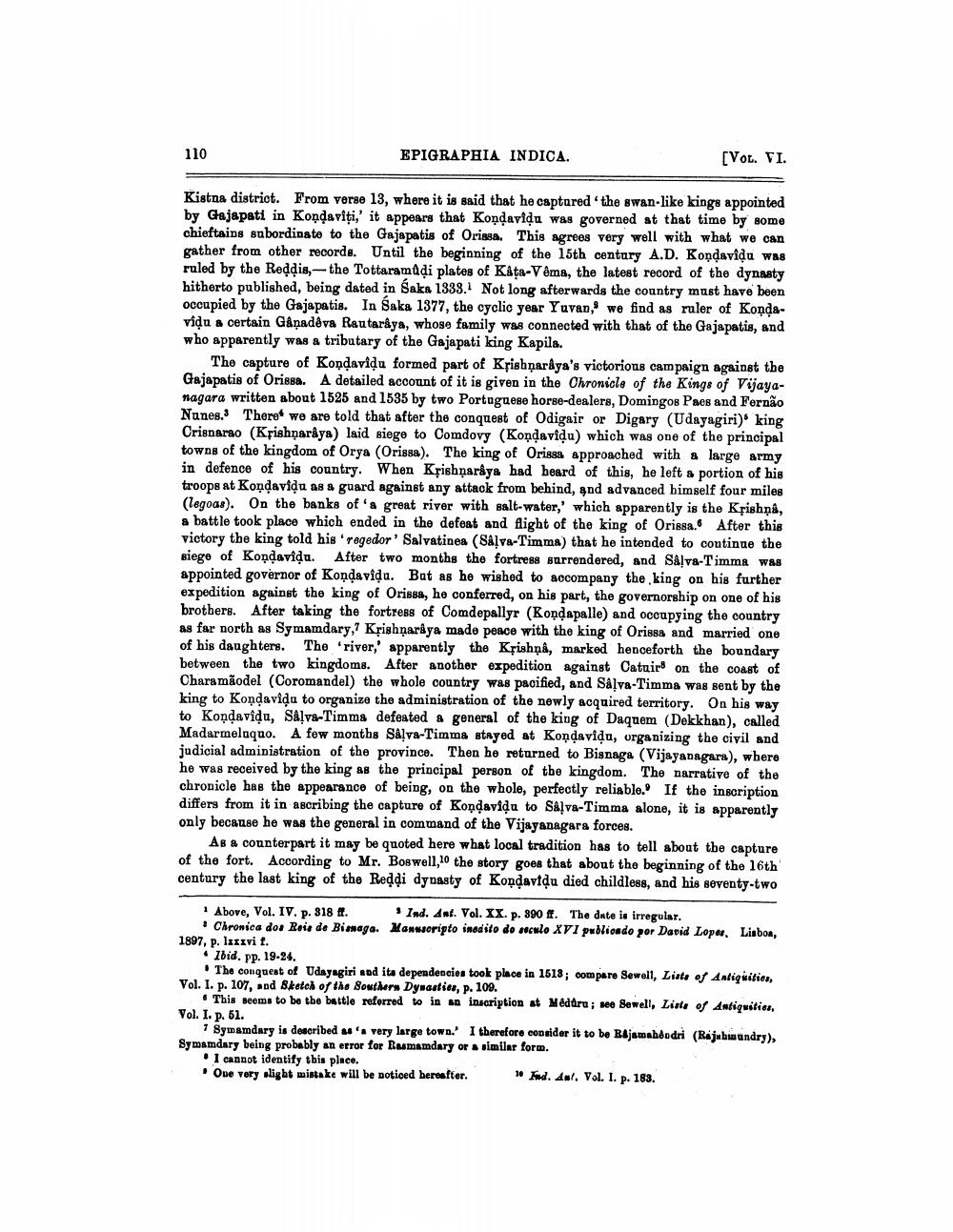________________
110
EPIGRAPHIA INDICA.
(VOL. FI.
Kistna district. From vorge 13, where it is said that he captured the swan-like kings appointed by Ghajapati in Kondaviti,' it appears that Kondavidu was governed at that time by some chieftains subordinate to the Gajapatis of Orissa. This agrees very well with what we can gather from other records. Until the beginning of the 15th century A.D. Kondaviņu was ruled by the Reddis,-the Tottaramadi plates of Kața-Vêma, the latest record of the dynasty hitherto published, being dated in Saka 1333. Not long afterwards the country must have been occupied by the Gajapatis. In Saka 1377, the cyclic year Yuvan, we find as ruler of Kondavidu a certain Gånadeva Rautaraya, whose family was connected with that of the Gajapatis, and who apparently was a tributary of the Gajapati king Kapila.
The capture of Kondavidu formed part of Krishnaraya's victorious campaign against the Gajapatis of Orissa. A detailed account of it is given in the Chronicle of the Kings of Vijayanagara written about 1525 and 1535 by two Portuguese horse-dealers, Domingo Paes and Fernão Nunes. There we are told that after the conquest of Odigair or Digary (Udayagiri) king Crisnarao (Krishnaraya) laid siege to Comdovy (Kondavidu) which was one of the principal towns of the kingdom of Orya (Orissa). The king of Orissa approached with a large army in defence of his country. When Krishnaråya had heard of this, he left a portion of his troops at Kondavidu as a guard against any attack from behind, and advanced himself four miles (legoas). On the banks of a great river with salt-water, which apparently is the Krishna, a battle took place which ended in the defeat and flight of the king of Orissa. After this victory the king told his "regedor' Salvatinea (S&ļva-Timma) that he intended to continue the siege of Kondavidu. After two months the fortress surrendered, and Så!V8-Timma was appointed governor of Kondavidu. Bat as he wished to accompany the king on his further expedition against the king of Orissa, he conferred, on his part, the governorship on one of his brothers. After taking the fortress of Comdepallyr (Rondapalle) and occupying the country as far north as Symamdary, Krishñaráya made peace with the king of Orissa and married one of his daughters. The 'river,' apparently the Kțishņâ, marked henceforth the boundary between the two kingdoms. After another expedition against Catuirs on the coast of Charamãodel (Coromandel) the whole country was pacified, and Sålva-Timma was sent by the king to Kondavida to organize the administration of the newly acquired territory. On his way to Kondavidu, Salva-Timms defeated a general of the king of Daquem (Dekkhan), called Madarmelaquo. A few months Salva-Timma stayed at Kondavidu, organizing the civil and judicial administration of the province. Then he returned to Bisnaga (Vijayanagara), where he was received by the king as the principal person of the kingdom. The narrative of the chronicle has the appearance of being, on the whole, perfectly reliable. If the inscription differs from it in ascribing the capture of Kondavidu to Salva-Timma alone, it is apparently only because he was the general in command of the Vijayanagara forces.
As a counterpart it may be quoted here what local tradition has to tell about the capture of the fort. According to Mr. Boswell,o the story goes that about the beginning of the 16th century the last king of the Reddi dynasty of Kondavidu died childless, and his seventy-two
1 Above, Vol. IV. p. 818 8. Ind. Ant. Vol. XX. p. 890 ff. The date is irregular.
Chronica dos Reis de Binnaga. Manusoripto inedito do wculo XVI publiondo por David Lopa, Lisboa, 1897, p. lxxxvi .
• Ibid. pp. 19-24.
. The conquest of Udayagiri sod ita dependencies took place in 1618; compare Sewell, Liste of Antiquities, Vol. I. p. 107, and Sketch of the Southern Dynasties, p. 109.
• This seems to be the battle referred to in an inscription at Médaru ; see Sewell, Lisle of Antiquities, Vol. I. p. 51.
7 Symamdary is described . ' very large town.' I therefore consider it to be Bajamahbodri (Rajubandry) Symamdary being probably an error for Rasmandary or similar form.
. I cannot identify this place. . Ove very slight mistake will be noticed hereafter.
Ind. Asl. Vol. I. p. 183.




